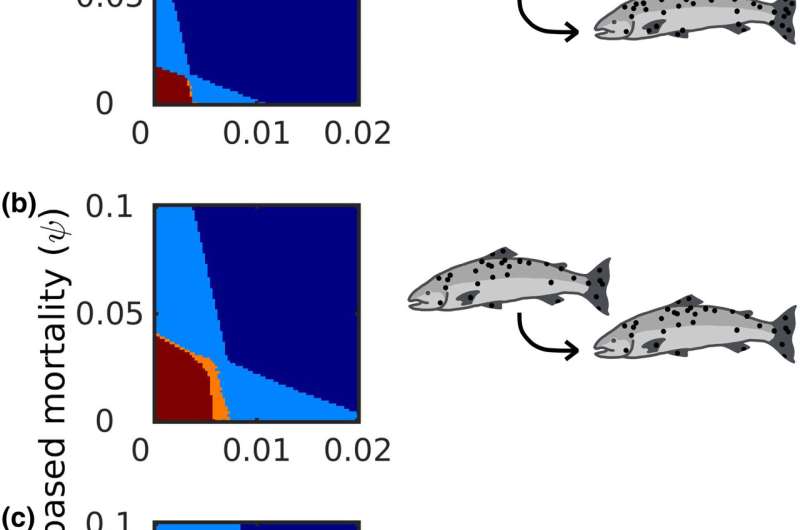This article has been reviewed according to Science X's editorial process and policies. Editors have highlighted the following attributes while ensuring the content's credibility:
fact-checked
peer-reviewed publication
trusted source
proofread
Modeling the dynamics of animal migration and parasitic infection

Migration is a survival mechanism for many species. Animals travel to find food, reproduce, reduce competition, escape predators or escape winter.
Whether mammal, bird, fish or insect, a migrating animal is exposed to parasites in the habitats it passes through, but it also has strategies to reduce infection for itself and its fellow creatures.
To identify the dynamics at work in parasitic infection and migration, Professor Sandra Binning of the Department of Biological Sciences at Université de Montréal and her colleague Allison Shaw of the University of Minnesota reviewed empirical studies and then created a model to understand the process.
Migration in decline
The diversity and inherent complexity of migratory behavior and its vital role in the ecology and survival of many species have been extensively studied. However, animal migration is now declining worldwide due to climate change and the destruction of many natural environments, and that has changed how it's studied.
"The solutions for stemming these losses are well-known: increase environmental protection, maintain habitat connectivity and reduce deforestation, for example," Binning observed. "But in many cases we lack data on the factors that promote or hinder migratory behavior in the first place."
Varying intensities of parasitic infestation
Over the past 10 years, Binning and Shaw have collaborated to develop a number of theories about the impact of parasites on migration and about migratory recovery, in which migration helps animals recover from parasitic infection.
The literature review they conducted, with the help of doctoral student Marie Levet, now published in Ecology Letters, has yielded a number of observations.
"For one thing, most migration studies focus on the end-point—reproduction or overwintering, for example—but neglect the stages of the journey, which are essential elements in the dynamics of infection during movement," Binning said.
They also found that the findings vary widely between studies: "In some studies, migrants show higher or lower infection intensity than non-migrating individuals of the same species," Binning reported. "In others, infection intensity may increase or decrease in the course of migration."
Types of migratory behavior
The literature review turned up a wide variety of migratory behaviors associated with parasites, some over long distances, others over shorter distances.
These behaviors fell into three main categories: migratory recovery, migratory escape and migratory culling. In the first case, the animal migrates to recover from infection; in the second, it migrates to escape a contaminated environment.
"For example, the large cervids (deer and other ruminants) of Europe and North America move to more remote northerly latitudes during the summer, which allows them to escape the ticks that proliferate in more southerly environments, or else they move to higher altitudes," Binning said.
In the case of migratory culling, the animal is so infected that it is unable to reach its destination, thus preventing it from infecting other individuals of the species.
The review also revealed a taxonomic bias in the research.
"Mammals and birds are over-represented in the studies compared with fish, reptiles and insects, which migrate in much greater numbers, but their migratory behavior has been little studied, with the exception of monarch butterflies," Binning noted.
She believes it is important to learn more about insect migration because of the vital role insects play in the food chain.
A predictive model for understanding migratory disruptions
The researchers have developed a unified evolutionary model based on the data from their review of the literature.
"Our model combines mathematics and biology," Binning explained. "It is based on a complex ecological approach that takes into account factors such as the distance traveled, the intensity of parasitic infection during migration, and the number of individuals that don't migrate."
By capturing the complexity of the movement patterns observed across a range of migratory species, she added, this model "will be very useful to scientists who want to more quickly predict the changes in movement, disease and environmental conditions that we are increasingly facing."
More information: Allison K. Shaw et al, A unified evolutionary framework for understanding parasite infection and host migratory behaviour, Ecology Letters (2023). DOI: 10.1111/ele.14301
Journal information: Ecology Letters
Provided by University of Montreal




















